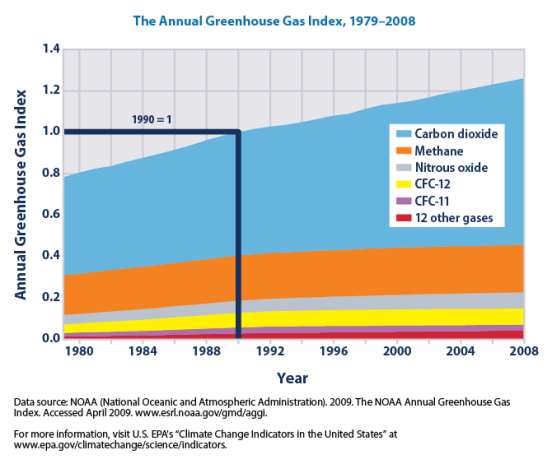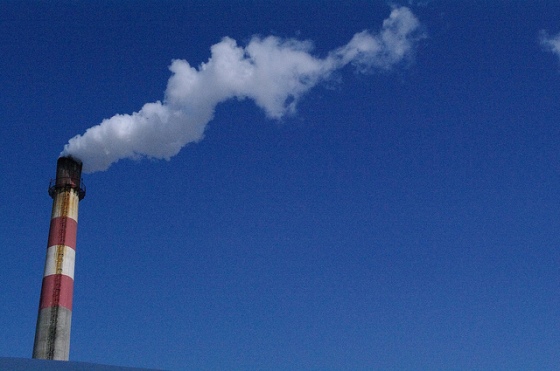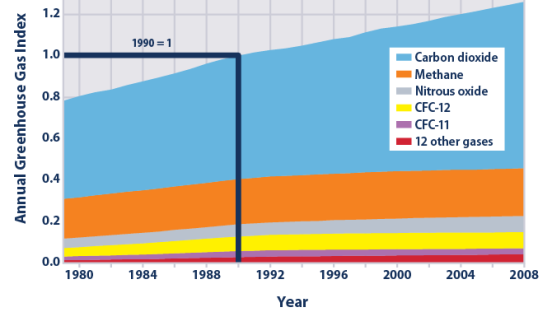As discussed in a previous post on the effects of ocean acidification, it is the decrease of the pH of the ocean caused by increasing carbon dioxide (CO2) levels. These acidic conditions that have already increased 25% over the past 200 years, dissolves coral skeleton and also makes it harder for coral growth. It is estimated that by the end of this century, the oceans will be 150 times more acidic, essentially making coral reef growth almost nearly impossible. So, what can we do to help this situation? Is there anything we can do to reverse or limit the damage we, humans, have already caused?

Greenhouse gases are gases that trap heat in the atmosphere, and carbon dioxide (CO2) is the primary greenhouse gas released through human activities. These human activities that release carbon dioxide into the atmosphere include solid waste, tree and wood products, chemical reactions such as the manufacturing of cement, and the real kicker, the burning of fossil fuels such as natural gas, coal, and oil. While carbon dioxide makes up about 82% of the United States’ greenhouse gas emissions, methane contributes about 10%, nitrous oxide makes up about 5%, and fluorinated gases such as hydrofluorocarbons, perfluorocarbons, and sulfur hexafluorides makes up about 3%. And as we can see in the picture above, the greenhouse gas trend has significantly increased from 1979 to 2008, and this trend has continued into the present. Now the question is, how do we decrease the release of greenhouse gases, specifically carbon dioxide?
Identifying the Problem
First, we must identify the source of our carbon dioxide emissions, where is all this excess carbon dioxide coming from? The main sources of carbon dioxide emissions that humans are responsible for break down into about 5 categories: electricity, transportation, industry, residential and commercial, and other.
Electricity
As many of us know, electricity is a huge source of energy for the United States, it is essential to our daily needs in our homes, businesses, work, etc. But where does all this electricity come from? Unfortunately, in 2015, the combustion of fossil fuels to generate electricity accounted for the primary source of carbon dioxide emissions, specifically 29%. The combustion of fossil fuels (coal, oil, natural gas), not only releases large amounts of carbon dioxide, but also releases smaller amounts of methane and nitrous oxide.

Industry
Industry is also another large player in emissions of greenhouse gases, and accounts for approximately 21% of the United States greenhouse gas emissions. Through the production of goods and raw materials that we rely on day in and day out, not only for jobs but also the production of these materials, we will ultimately suffer consequences of great proportions through the emissions of greenhouse gases. The greenhouse gases emitted can be categorized into direct emissions and indirect emissions. Direct emissions are produced when fuel is burned through chemical reactions and industrial processes for heat and/or power, while indirect emissions occur when fossil fuels are burned at a power plant to create electricity, that is then used by the industrial facility to operate.

Transportation
Transportation is also a daily necessity to humans, but it has come with a price. Transportation alone makes up about 27% of the United States greenhouse gas emissions, second to electricity. Traveling accommodations such as cars, trucks, planes, ships, or trains, happen to be a huge source of carbon dioxide emissions caused by the burning of petroleum-based products like gasoline and diesel. While one would think that planes, trains, and ships would be the largest source of these carbon dioxide emissions, simply based on size, it is actually the smaller cars, trucks, sports cars, minivans, and SUVs that are guilty due to sheer abundance of them.
Commercial and Residential
Commercial and residential sector emissions make up a smaller portion, but still significant proportion of the United States greenhouse gas emissions, at about 12%. Commercial and residential sector emissions are also broken up into direct and indirect emissions. Direct emissions include the burning of fossil fuels for our daily heating and cooking needs, as well as the management of waste products. Indirect emissions is still the burning of fossil fuels, but it is offsite, and then is used for electricity in homes and businesses.
Agriculture
The ‘other’ category includes agriculture, which equates to approximately 9% of the United States green house gases. Practices in agriculture such as using synthetic and organic fertilizers, growing nitrogen-fixing crops, draining organic soil, and other irrigation activities leads to the increase in nitrogen in the soil, causing nitrous oxide emissions. Cattle and other livestock also release large amounts of ethane through their normal digestion processes, but this actually makes up about one-third of the agriculture’s 9% of all of the United States greenhouse gas emissions. In addition, manure treatment and storage methods actually causes about 15% of the agriculture’s sector of greenhouse gases. And these listed above are just some of a few practices causing spikes in greenhouse gases, not just in the United States, but across the world. As you can see, we have abused this one source by burning fossil fuels in several different capacities on top of agricultural practices and emissions, essentially causing this surge in greenhouse gas emissions, that we’ve clearly been seeing for years and have repeatedly ignored.
Lowering Carbon Dioxide Levels
While the increase in carbon dioxide levels have vastly and deleteriously affected an infinite number of things on this Earth, by decreasing levels of carbon dioxide, we will likewise positively impact the earth, specifically ocean acidification. A good place to start, would be to calculate your carbon footprint. After seeing where you stand, look at this list of things you can do everyday to do your part in lowering greenhouse gas emissions.
- Educate yourself through research and raise awareness to those around you about their actions and the potential consequences we will soon face if nothing changes.
- Home energy audit and replace old dial to a programmable thermostat, or seal any insulating, heating, and cooling units you may have.
- Use RENEWABLE energy such as wind, solar, geothermal, and hydroenergy.
- Purchase solar panels! (fun fact: the government will give you an incentive!)
- Buy green tags if your energy company doesn’t offer green power by buying green tags, which are compensatory energy credits that add renewable energy to the power grid to offset your usage (super cool!).
- Buy carbon offsets and plant trees and purchasing low-carbon technology to offset your own usage.
- Turn your thermostat down 3
ºF, in the winter, and 3ºF in the summer-this will reduce your carbon dioxide emissions by 1,050 pounds per year (wow). - Install solar lights!
- Only buy energy-saving light bulbs.
- Buy appliances with the Energy-Star Label
- Turn off all electronics when not in use, especially TVs and computers!
- Install tankless water heaters– they only warm up as much water as needed!
- Wash clothes in cold or warm water-not hot water
- Don’t use your dryer, either hang dry your clothes, or line dry your clothes instead.
- Use non-toxic household products!
- REDUCE, REUSE, RECYCLE (and actually do it!)
- Instead of driving everywhere, bike, unicycle, scooter, walk, jog, or hop on one leg…
- Plant more trees!!!
- Encourage and collaborate with friends, family, and neighbors by sharing all your research and ideas!
- Sharing is caring, and knowledge is power, so use it for good.
Who’s ready to make a change?




An excellent follow up post to your original. The complex problems associated with greenhouse gas emissions and the variety of reasons for CO2 production are certainly overwhelming. I am really glad that you included a list to help people understand some ways in which they can reduce their carbon footprint. It is the smaller steps that add together when many people get involved that can truly make a difference!
LikeLike
I agree with Dr. C on this post! I really like how you followed up on a previous blog post topic. I did not know how much electricity contributes to carbon emission. I think this post is laid out easy to read and follow as well as a great post to help people learn what they can do to reduce CO2 production.
LikeLike
What a great post Jaime! You really thought well and hard about this topic, and it is clear that you were interested in writing this. I liked how you tied your other post into this one. You included some really awesome graphics in this post, especially the first graph. I also liked how you included ways that we can reduce our carbon footprint.
LikeLike
This post is similar to mine regarding our carbon footprint. It amazing to see how much emissions we actually put out on a day to day basis. I have gotten in the habit of unplugging anything I am not using and recycling a lot more. Great post!
LikeLike